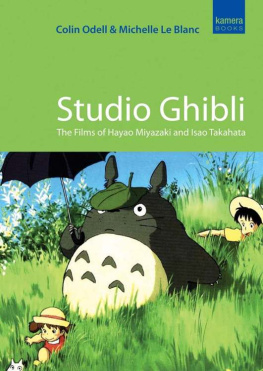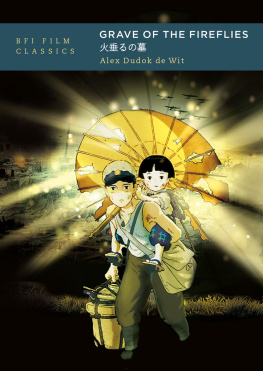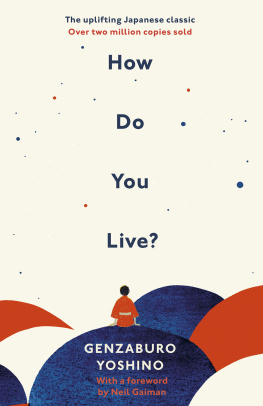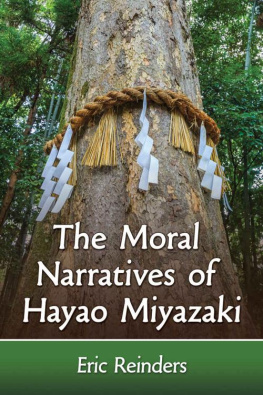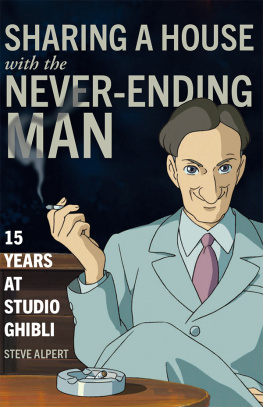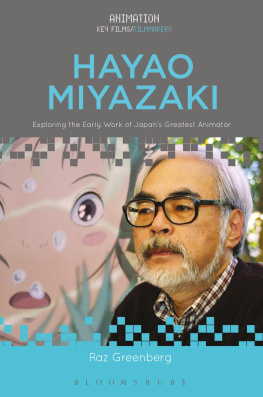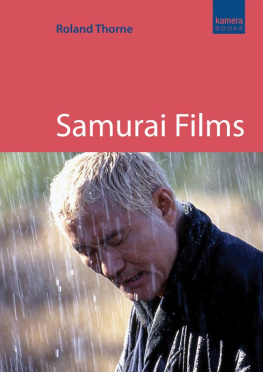le Blanc Michelle - Studio Ghibli: The Films of Hayao Miyazaki and Isao Takahata
Here you can read online le Blanc Michelle - Studio Ghibli: The Films of Hayao Miyazaki and Isao Takahata full text of the book (entire story) in english for free. Download pdf and epub, get meaning, cover and reviews about this ebook. year: 2009, publisher: Oldcastle Books, genre: Romance novel. Description of the work, (preface) as well as reviews are available. Best literature library LitArk.com created for fans of good reading and offers a wide selection of genres:
Romance novel
Science fiction
Adventure
Detective
Science
History
Home and family
Prose
Art
Politics
Computer
Non-fiction
Religion
Business
Children
Humor
Choose a favorite category and find really read worthwhile books. Enjoy immersion in the world of imagination, feel the emotions of the characters or learn something new for yourself, make an fascinating discovery.
- Book:Studio Ghibli: The Films of Hayao Miyazaki and Isao Takahata
- Author:
- Publisher:Oldcastle Books
- Genre:
- Year:2009
- Rating:3 / 5
- Favourites:Add to favourites
- Your mark:
- 60
- 1
- 2
- 3
- 4
- 5
Studio Ghibli: The Films of Hayao Miyazaki and Isao Takahata: summary, description and annotation
We offer to read an annotation, description, summary or preface (depends on what the author of the book "Studio Ghibli: The Films of Hayao Miyazaki and Isao Takahata" wrote himself). If you haven't found the necessary information about the book — write in the comments, we will try to find it.
Studio Ghibli: The Films of Hayao Miyazaki and Isao Takahata — read online for free the complete book (whole text) full work
Below is the text of the book, divided by pages. System saving the place of the last page read, allows you to conveniently read the book "Studio Ghibli: The Films of Hayao Miyazaki and Isao Takahata" online for free, without having to search again every time where you left off. Put a bookmark, and you can go to the page where you finished reading at any time.
Font size:
Interval:
Bookmark:
Colin Odell & Michelle Le Blanc
THE FILMS OF HAYAO MIYAZAKI
& ISAO TAKAHATA
kamera
BOOKS
For Marika
Our thanks as always to the people whose enthusiasm and support have provided invaluable assistance in the production of this book. To all the people who have entertained us in Japan Gavin and Hanako Bell, Ono Mio and family, Akayama Kenji, Yaegeshi-Nakaya Kaori and Nakaya Kazutoshi and family. Thanks to all our language teachers Yoshiko, Taeko, Mike and Miho who have taught us Japanese with patience, good grace and humour. And thanks to all the people with whom weve enthused at length about Ghibli and Japan: Paul & Lizbeth, Gavin & Hanako, Andy, Yoshiko & David, Graham & Kirsty, Jane & Tracy, and Gordon. Our love to Christine, Tony and Marc Le Blanc, and Truus Odell. Thanks also to Anne Hudson and to Hannah Patterson for taking this on. And finally to Azumi, our very own cuddly nekobasu , even if she does chuck Totoro off the windowsill with alarming regularity.
Special thanks to Yoshiko Miura, Hanako Bell and Gareth & Satoko Bailey for their advice, support and translation expertise.
THE FILMS OF HAYAO MIYAZAKI
& ISAO TAKAHATA
A teenage witch, her hair ruffled by the wind, rides her mothers broom through the open skies. A giant robot unleashes molten destruction on the soldiers who have awakened him from centuries of slumber. A city worker recalls her childhood growing up in the 1960s. The skies above Kbe are filled with buzzing agents of death, raining down fire upon a terrified population. A burgeoning writer finds inspiration in a quaint antiques shop. A travelling warrior becomes infatuated with a feral wolf-child in a land scarred by war. A group of young people discover love and loss during their turbulent high-school years. A girls parents are turned into slobbering pigs. A father turns superhero, if only for a moment, when he stands up to a local biker gang. Two elated girls soar through the air inside a grinning cat bus, its headlight eyes tracing yellow streaks in the sky above the forest. Gods and monsters. Love and loss. Jubilation and despair. The horrors of war. Childhood wonder. Welcome to the heart-soaring, euphoric, whimsical, terrifying, compassionate and, above all else, emotional world of Studio Ghibli.
The remarkable films of Studio Ghibli show, without a shadow of a doubt, that cinema can be art. Often the terms art and cinema result in products that distance audiences, but Ghibli makes films that touch the soul, that can enrapture and delight everyone from toddlers to pensioners. Crucially, they retain the one thing thats frequently lacking in commercial cinema integrity. It is this, combined with an unprecedented box-office might in their native Japan, that has allowed the animators at Studio Ghibli to continue their work without compromising their artistic vision, telling the stories they want to tell, the way they want to tell them. Animation has often been dismissed, particularly in the West, as simplistic and aimed at children but, despite their appeal to children, Ghiblis films are universal. Put simply, Studio Ghibli is the finest animation company working today, a bold claim perhaps when comparing them with the mighty Pixar (huge Ghibli fans themselves), but one that holds.
Studio Ghibli was founded in 1985 when Miyazaki Hayao brought together Takahata Isao and producer Suzuki Toshio in order to make animated films the way they wanted to make them. Years of working for various companies producing film and television programmes had left the trio eager for artistic freedom, unhindered by external studio pressures. Now, outside Hollywood, Studio Ghibli is the most profitable animation company in the world. In Japan their films regularly break box-office records and run in cinemas for months on end. On the international stage they are highly regarded, having won numerous prestigious awards, including the Academy Award for Best Animated Feature for Spirited Away (2001), the only non-English-language film to have won in this category. Their box-office clout is indeed formidable, with no less than three of their features in the top-ten-grossing non-English-language films of all time. Their artistry is an inspiration to filmmakers the world over. Despite making films for their home market, they are among the most critically acclaimed studios in the world.
Confusion often arises as to what is and is not a Studio Ghibli film. This is because Takahata and Miyazakis styles are so distinctive and the Ghibli brand so ubiquitous that many of the films the pair worked on prior to forming the studio are often claimed as Ghiblis. This view is further clouded because an increasing number of these works are now released under the Ghibli banner, most notably Miyazakis Nausica of the Valley of the Wind (1984), Takahatas Gshu the Cellist (1982) and the pairs breezy Panda Kopanda films (1972 and 1973), none of which are technically Ghibli films. Further confusion has been created by the addition of the Studio Ghibli logo, a profile of their mascot Totoro, to many of the films acquired later by the studio. In this book we will be covering the major pre-Ghibli works by Takahata and Miyazaki because they are crucial to understanding the artists development and the emergence of the Ghibli house style.
There are, of course, many people working for Studio Ghibli, but the most notable are its founders. Takahata Isao was born on 29 October 1935 in Ise, the city that hosts the most sacred shrine of Japans indigenous religion Shint. Miyazaki Hayao was born in the modern capital Tky on 5 January 1941. These were difficult and turbulent times for Japan; the long campaigns of World War II had left the country devastated and hungry. Following Japans defeat in 1945 the country was occupied by the United States and, although it would eventually become one of the worlds leading economic powers, the early post-war years were particularly harsh.
Takahata attended the University of Tky, graduating in French Literature. It was French animator Paul Grimaults unfinished Le Roi et loiseau (1948, but finally finished in 1980) that intrigued him as to the possibilities of working in animation. Perhaps it was for this reason that he applied for a job as assistant director at the fledgling Tei Dga studio, working on features and TV shows.
Miyazaki grew up with his three brothers, father and mother, the latter a free-thinking spirit who inspired her sons to question everything. As a result of his mothers long-term illness, the family had to move around the country seeking the best medical support, a situation many commentators have linked to the genesis of My Neighbour Totoro (1988). Miyazakis father worked for his brother at Miyazaki Airplane, and Hayao developed a love of flying machines. He began drawing what he saw as well as imagining new forms of aviation. These roots would later see him designing flying machines not only for his animated movies but also specialist modeller magazines. Miyazaki expanded his drawing skills from vehicles to people when, like many growing up in the post-war years he became inspired by manga, Japanese comics that had been popularised by artist Tezuka Osamu. Initially, Miyazaki was only an enthusiastic hobbyist, but all that changed when, following graduation in political science and economics at Gakushuin University, he too joined the growing ranks of workers at Tei Dga.
Although Japan had made animated films (anime) before, the tidal wave of production really took off in the early 1960s, partly because of the work of Tezuka Osamu and partly on the back of what is often acknowledged as Japans first feature-length colour anime Hakujaden ( Legend of the White Serpent , 1958). An offshoot of its parent company Tei, one of Japans big movie studios, Tei Dga quickly established itself as a major player in the burgeoning market, making feature films and, most importantly, TV anime.
Font size:
Interval:
Bookmark:
Similar books «Studio Ghibli: The Films of Hayao Miyazaki and Isao Takahata»
Look at similar books to Studio Ghibli: The Films of Hayao Miyazaki and Isao Takahata. We have selected literature similar in name and meaning in the hope of providing readers with more options to find new, interesting, not yet read works.
Discussion, reviews of the book Studio Ghibli: The Films of Hayao Miyazaki and Isao Takahata and just readers' own opinions. Leave your comments, write what you think about the work, its meaning or the main characters. Specify what exactly you liked and what you didn't like, and why you think so.

